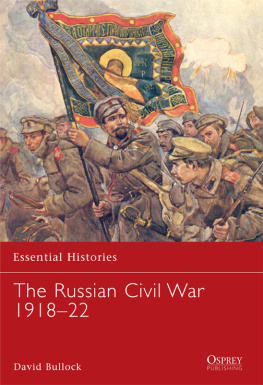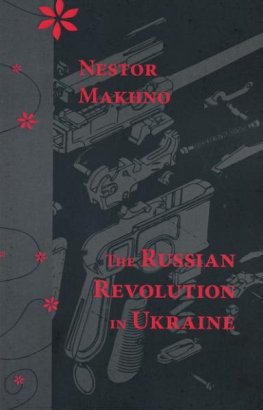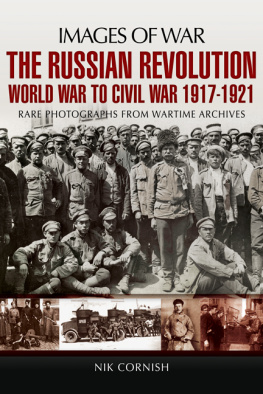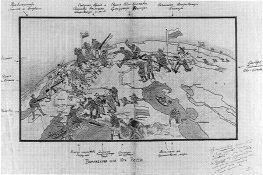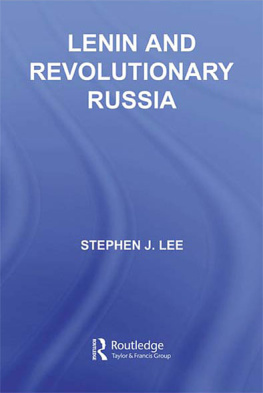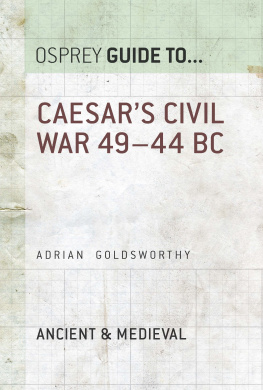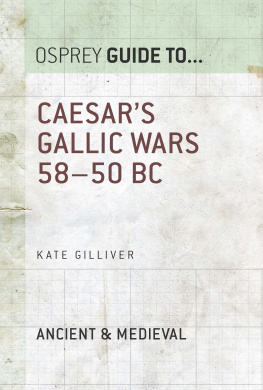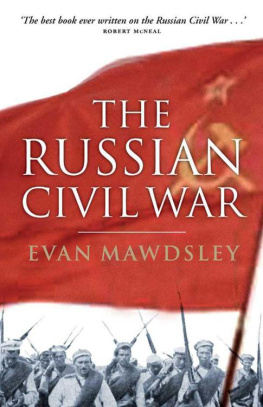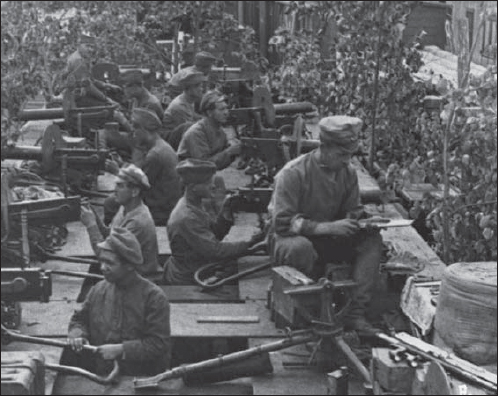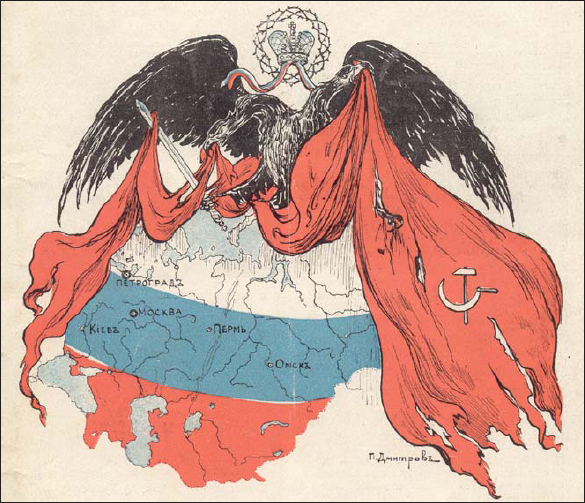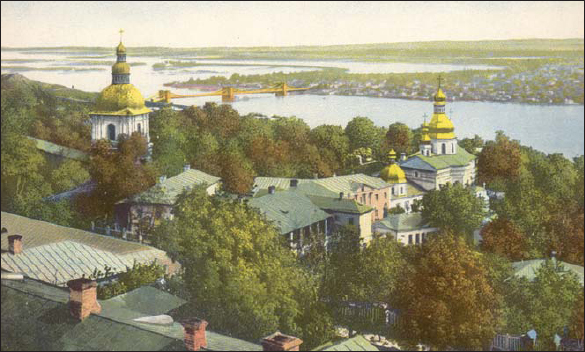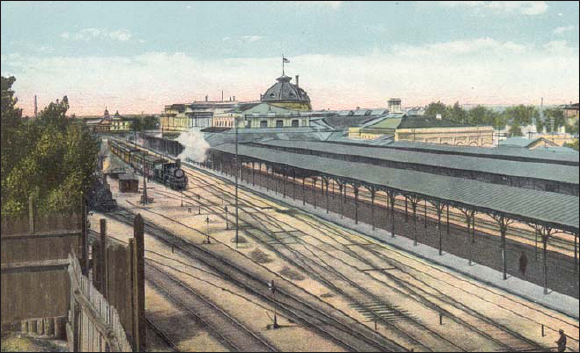Essential Histories
The Russian Civil War 191822
David Bullock
Contents
The former Russian Empire in the national flag colours of red, blue and white. Overhead, the state crown is surrounded by a wreath of thorns symbolizing suffering and sacrifice. The imperial eagle has been replaced by a black eagle with sword and extended talons that spreads the red cloak of communism over the land. (Chasevoi migr journal, 1933)
Introduction
The Russian Civil War of 191822 arose out of the cataclysmic events of World War One. This civil war dwarfed all others of the 20th century in scope and significance. The lives of tens of millions were lost or changed forever in the ensuing conflagration from battle, disease, famine, imprisonment, execution, dislocation and exile.
New weapons of war emerged. The aeroplane, armoured car, tank and armoured train were tested over the vast expanses of Russia, the largest country in the world, in a war of mobility not seen on the relatively static fronts that characterized World War One. Even so, the older weapons of war remained. This was the last war in which cavalry armies duelled en masse, sword on lance. Bugles still rang and unfurled flags fluttered above infantry charging into the steel mouths of guns.
Kiev, capital of the Ukraine. Note the Nicholas (chain) Bridge in the background. The city changed hands 19 times during the civil war. (Bullock collection)
More than two dozen countries took part in these torturous years of civil war. Peripheral regions of the former Russian Empire that had broken away to form new nations had to fight for independence: Finland, Poland, Estonia, Lithuania, Latvia, Belarus, Ukraine, Georgia and Azerbaijan. Other countries directly intervened in the conflict as a consequence of events arising out of World War One, including Great Britain, France, Italy, Canada, Japan, Germany, Austria-Hungary, Romania, Greece, the Ottoman Empire and the United States.
Still others participated in the fighting because their troops were trapped inside Russia at the end of World War One, such as Serbia and Czechoslovakia, or fought because the civil war spilled over into their territory, for example, Mongolia and China. At the end, the maps of northeastern and eastern Europe, the Caucasus, Central Asia and the Far East had to be redrawn.
Historiography poses the question when did the Russian Civil War begin? Historians, authors, politicians and diplomats have had their own points of view depending on when their country or party interest became involved, or to stress a particular methodology or ideological line of argument. This books position is that the era of the Provisional Government, from April to November 1917, was a time of transition between the fall of the tsar and the outbreak of civil war. Civil war began when an organized opposition sought to overturn the October Revolution of 1917. In this context, civil war began when notable White generals formed the Volunteer Army in South Russia in November/December 1917. However, that force did not engage in significant military action until the opening days of 1918.
The question when did the civil war end? is equally problematical. The majority of Whites on the Southern Front thought the conflict ended in November 1920 after defeat in the Crimea and exile. Whites in the Northern and Northwestern Fronts had already accepted defeat that February. Whites in the Far East continued battle actions until 1922, notwithstanding one final act of quixotic desperation in Yakutsk in spring 1923.
For many Reds, the civil war certainly ended in 1922, after the last of the major peasant and internal rebellions had been fully crushed and after the last of the foreign interventionists left Russian soil. However, spasmodic resistance occurred in the Ukraine, the Caucasus, Central Asia and the Far East well into the 1920s.
Red victory in the Russian Civil War unleashed the new doctrine of communism with its concept of international revolution upon the world. This set the stage for the Cold War that began in the late 1940s and which divided the world into two armed political camps, communist and anti-communist. But this path, of course, was never certain, for the outcome could only be decided in the severe trials of civil war.
Chronology
(Dates are given in Western, Gregorian calendar style and are 13 days ahead of Eastern or Julian calendar style. The following represents only a few of the important dates in this momentous period.)
1917 7 March Start of February Revolution
15 March Tsar Nicholas II abdicates
15 March Formation of Provisional Government
16 April Lenin returns to Russia
3 May Demonstrations in Petrograd (formally St Petersburg but the name was changed during World War One to sound less German)
18 May Provisional Government reorganizes
2 July July Offensive begins
1618 July July Days attempted Bolshevik coup
21 July Alexander Kerensky becomes prime minister of Provisional Government
1 August General Lavr Kornilov becomes commander-in-chief
614 September Kornilov attempts to restore order
6 October Leon Trotsky becomes chairman of the Petrograd Soviet
25 October Formation of the Military Revolutionary Committee
7 November October Revolution begins
13 November Kerenskys counter-revolution fails
15 November Mikhail Alexiev establishes the Volunteer Army in the Don
20 November Central Rada declares Ukrainian independence
2 December Generals Kornilov, Denikin, Romanovsky, Lukomsky and Markov escape from Bykhov and head for the Don
6 December Finland declares independence
20 December Establishment of the Cheka
22 December Peace negotiations begin at Brest-Litovsk
1918 12 January Latvia declares independence from Russia
19 January Bolsheviks shut down Constituent Assembly
8 February Red Army takes Kiev
9 February Ukrainian Rada makes peace with Central Powers
14 February Soviet Russia adopts the Western or Gregorian calendar
14 February Grigori Semenov raises army in Trans-Baikal region
16 February Lithuania declares independence
19 February Central Powers advance through Ukraine
22 February Volunteer Army evacuates Rostov-on-Don and begins Ice March
24 February Estonia declares independence
25 February Don Cossack Front collapses under General A. Kaledin
2 March Germans enter Kiev
3 March Treaty of Brest-Litovsk signed
12 March Bolsheviks move government and capital from Petrograd to Moscow
14 March Red Army captures Ekaterinodar
3 April German forces land in Finland
4 April British landings begin in Siberia
5 April Initial landing of the Allies at Murmansk

